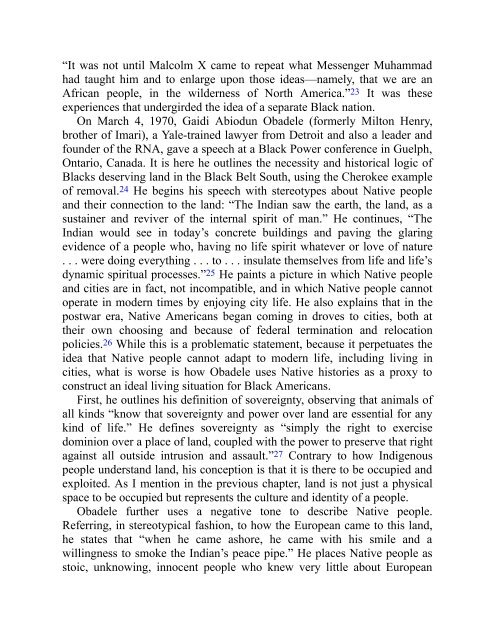Create successful ePaper yourself
Turn your PDF publications into a flip-book with our unique Google optimized e-Paper software.
“It was not until Malcolm X came to repeat what Messenger Muhammad<br />
had taught him and to enlarge upon those ideas—namely, that we are an<br />
African people, in <strong>the</strong> wilderness <strong>of</strong> North America.” 23 It was <strong>the</strong>se<br />
experiences that undergirded <strong>the</strong> idea <strong>of</strong> a separate Black nation.<br />
On March 4, 1970, Gaidi Abiodun Obadele (formerly Milton Henry,<br />
bro<strong>the</strong>r <strong>of</strong> Imari), a Yale-trained lawyer from Detroit and also a leader and<br />
founder <strong>of</strong> <strong>the</strong> RNA, gave a speech at a Black Power conference in Guelph,<br />
Ontario, Canada. It is here he outlines <strong>the</strong> necessity and historical logic <strong>of</strong><br />
Blacks deserving land in <strong>the</strong> Black Belt South, using <strong>the</strong> Cherokee example<br />
<strong>of</strong> removal. 24 He begins his speech with stereotypes about Native people<br />
and <strong>the</strong>ir connection to <strong>the</strong> land: “The Indian saw <strong>the</strong> earth, <strong>the</strong> land, as a<br />
sustainer and reviver <strong>of</strong> <strong>the</strong> internal spirit <strong>of</strong> man.” He continues, “The<br />
Indian would see in today’s concrete buildings and paving <strong>the</strong> glaring<br />
evidence <strong>of</strong> a people who, having no life spirit whatever or love <strong>of</strong> nature<br />
. . . were doing everything . . . to . . . insulate <strong>the</strong>mselves from life and life’s<br />
dynamic spiritual processes.” 25 He paints a picture in which Native people<br />
and cities are in fact, not incompatible, and in which Native people cannot<br />
operate in modern times by enjoying city life. He also explains that in <strong>the</strong><br />
postwar era, Native Americans began coming in droves to cities, both at<br />
<strong>the</strong>ir own choosing and because <strong>of</strong> federal termination and relocation<br />
policies. 26 While this is a problematic statement, because it perpetuates <strong>the</strong><br />
idea that Native people cannot adapt to modern life, including living in<br />
cities, what is worse is how Obadele uses Native histories as a proxy to<br />
construct an ideal living situation for Black Americans.<br />
First, he outlines his definition <strong>of</strong> sovereignty, observing that animals <strong>of</strong><br />
all kinds “know that sovereignty and power over land are essential for any<br />
kind <strong>of</strong> life.” He defines sovereignty as “simply <strong>the</strong> right to exercise<br />
dominion over a place <strong>of</strong> land, coupled with <strong>the</strong> power to preserve that right<br />
against all outside intrusion and assault.” 27 Contrary to how <strong>Indigenous</strong><br />
people understand land, his conception is that it is <strong>the</strong>re to be occupied and<br />
exploited. As I mention in <strong>the</strong> previous chapter, land is not just a physical<br />
space to be occupied but represents <strong>the</strong> culture and identity <strong>of</strong> a people.<br />
Obadele fur<strong>the</strong>r uses a negative tone to describe Native people.<br />
Referring, in stereotypical fashion, to how <strong>the</strong> European came to this land,<br />
he states that “when he came ashore, he came with his smile and a<br />
willingness to smoke <strong>the</strong> Indian’s peace pipe.” He places Native people as<br />
stoic, unknowing, innocent people who knew very little about European


















